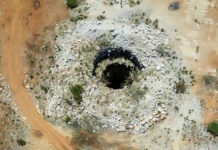[miningmx.com] — HARMONY Gold’s reserves and resources statement has probably suffered more inflation than has been imputed to the actual figures. The controversy, which has been a matter of public scrutiny since last year, does prove however that Gold Fields’ has more human resources than its suitor. In truth, Harmony has struggled to repel the aggressive public relations campaign waged against it by Gold Fields of which the “true’ nature of its reserves and resources has dominated.
Gold Fields’ contention is that the changeable nature of Harmony’s reserves statement is tantamount to lying about the economics of its bid for Gold Fields. Harmony rebuts that reserve statements are an inexact science describing one scenario among many. Variations in the figures are accommodated by means of sensitivity analyses with the great imponderable being the prevailing domestic price of gold.
At any rate, a Competent Persons’ Report (CPR) on Harmony’s reserves and resources statement was issued on Sunday, the day when the Competition Tribunal was also (idiosyncratically) reconvened. The fact that it was Mothers Day in South Africa has incidental relevance but demonstrates how the Harmony, Gold Fields saga has become an all-absorbing circus on wheels to those close to it. So while Ma sat at home, her grown up boys and girls set about what has barely been analysed before in such detail, particularly by reporters, the de facto ringmasters of the Big Top.
Consulting engineer SRK’s assessment of the reserves simply states that Harmony’s mineable gold, depending on economic conditions, is between 52m and 32m oz. These revelations don’t differ much from Harmony’s own guidance when it spoke to analysts and media during the last quarter. But Gold Fields’ continues to admonish its counterparts at Harmony?
The size of Harmony’s gold reserves shouldn’t matter in itself. It’s worth considering, for example, that IamGold Corp, a North American firm with which Gold Fields unsuccessfully attempted a reverse listing last year, had just over 12m oz of attributable gold in all categories of reserve and resource estimation. Compare this against Gold Fields’ 2004 total of 75.6m oz, a disparity in mineral wealth that shows mergers or takeovers don’t have to be between equals. They rarely are.
Gold Fields also has no beef with one of the most important metrics in Harmony’s assumptions. According to new Securities Exchange Committee (SEC) regulations, mining companies are required to submit three-year gold price averages when estimating gold reserves. This allowed AngloGold Ashanti, for instance, to estimate gold reserves on a gold price of R95,000/kg, roughly R10,000/kg above the historical six month average price. Harmony applied R92,000/kg to its reserves, and Gold Fields the yet more conservative R90,000/kg.
“You’ve got to plan for the upside,’ says Christian Siebert, an analyst with Citigroup Smith Barney, a critic of Harmony’s tackling of its reserves statement. Siebert’s objection, however, is the way Harmony packaged its statement disclosing inferred gold reserves where none had been inferred before, and including potential gold retrieved from vamping, gold swept from ore passes.
Siebert observes that, including gold from vamping, equal to one million ounces in Harmony’s books, a form of double counting is afoot. He also objects to the way so-called “below infrastructure’ gold resources are combined with resources that don’t require additional capital expenditure to mine. In summary, Harmony’s reserves statement has been attacked on its packaging.
There’s nothing wrong SRK’s scenario planning of Harmony’s reserves since the much-vaunted quality of gold optionality is based on such things. And although Siebert says he is wary of so-called gold optionality, North American investors buy South African gold stocks for their rand hedge possibilities. In practice, this means a sudden weakening of the gold price would make a meaningful impact on reserves Harmony could mine, including about 10m oz at its Rolspruit and Poplar properties.
Gold Fields has disputed the feasibility of these deposits as they only become economically mineable at R140,000/kg, nearly double the current price. But there’s a thriving market for such optimism in North America, one from which Gold Fields has also benefited.
Eventually, however, one can’t discount whether the debate about fair reserve announcements is now a matter of overkill. The value of Harmony’s bid for Gold Fields has dropped by $3bn in value since October. Georges Lequime, in an earlier miningmx story, believed this signalled an end to the bid. “The bid is not an issue anymore. The game is over,’ he said.
Notwithstanding, Swanepoel has today resumed a roadshow aimed at convincing Gold Fields shareholders of the original merits of his company’s bid “Now this reserve matter is over, there should be no impediment to Gold Fields shareholders making their minds up,’ he says. Harmony expects a decision on whether its bid met with Competition Tribunal criteria by Wednesday, Swanepoel said.











